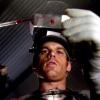But if you were to calculate MBB, then your MBB as an OBB would be much better quality than non-MBB-OBBs, right?
Yeah, sorta, kinda, not really. Close-enough is close-enough.
For example, you could use a sphere-tree for fast, gross, culling then resort to a "triangle perfect" collision detection.
What you really want for physics is a CSG representation of the model (constructive-solid-geometry) and perform the collision against that.
This allows you to describe curves, spheres, cylinders (i.e. wheels) accurately without requiring excessive tessellation.
It depends on what you are using the collision detection for.
You might have one collision mesh or geometry for movement collisions and a different one for detecting damage (to detect the location hit).
- The trade-off between price and quality does not exist in Japan. Rather, the idea that high quality brings on cost reduction is widely accepted.-- Tajima & Matsubara





